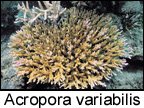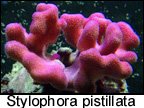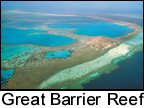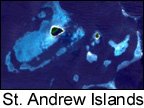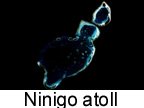"There are many things besides zooplankton which reefers can use to feed their corals, just like the ocean does. Some of the less-obvious ones (because they are invisible) are DOC and DOM. These are Dissolved Organic Carbon, and the larger category, Dissolved Organic Matter. The general definition of 'dissolved' is that it is a particle less than a half micron in size:"
"Encyclopedia of Earth:"
"Marine dissolved organic matter is a complex mixture of molecules of diverse origins found in seawater from throughout the world ocean. The concentrations of individual molecules are low, but there are tens of thousands of different molecules in seawater, and the volume of the world ocean is large, making this a major global reservoir of non-living organic matter. The total amount of marine dissolved organic matter is most commonly measured as the organic carbon in seawater that has passed through a filter with a pore size of about 0.5 microns to remove large particles and organisms."
.
.
.
.
"In-situ [in the ocean] release of mucus and DOC-lipid from the corals Acropora variabilis and Stylophora pistillata in different light regimes. Coral Reefs, July 1987:"
"Scleractinian corals release particulate and dissolved organic carbon (POC, DOC), of which a major constituent is mucus, an important component in coral reef trophodynamic [feeding] processes.
.
.
.
.
"Linkage of small-scale spatial variations in DOC, inorganic nutrients, and bacterioplankton growth, with different coral reef water types. Aquatic Microbial Ecology, March 2001:"
"Coral reefs are characterized by relatively high gross primary productivity [growth from the sun] sustained by the symbiosis between corals and symbiotic algae, and the large photosynthetically active area of reef surfaces, ample light, and inorganic carbon [CO2 etc]. Moreover, coral reefs are well known to trap [eat] particulate organic matter and nutrients from the overlying water. Nevertheless, the gross respiratory consumption [what reefs "give off"] in reef systems is approximately equal to the gross photosynthetic fixation [what reefs "take in"], and the net flux [movement] of organic matter is typically small. [meaning a reef recycles the DOC and DOM, just like an aquarium does]"
"It has been recognized that in coral reef waters, a flux [movement] of dissolved and particulate material [food] emanates from benthic [sea floor] algae and corals, and from the underlying sediment. Dissolved organic matter accumulates over coral reefs and in lagoons, compared to adjacent oceanic surface waters, indicating that in reef waters the production of dissolved organic carbon (DOC) exceeds the loss. Part of the gross primary production of corals is released as mucus, DOC, and DON [dissolved organic nitrogen]."
"In the mucus layer of stony corals, extremely active microbial communities have been found, compared to ambient water [the microbes eat the DOC/DOM]"
"The highest DOC concentrations of all reef water types were found in the Coral Surface. Live coral is apparently the main source of DOC in the reef structure. It is well known that corals allocate 50 percent of the gross primary production into mucus. DOC apparently emanates from the mucus layer of corals, into the Coral Surface and ambient water."
"The primary consumers of DOC are heterotrophic bacteria, which take up the bioavailable organic matter [and the bacteria then feed other corals]."
.
.
.
.
"Aspects of the biomass, feeding, and metabolism of common corals of the Great Barrier Reef, Australia. Proceedings of the Fourth international Coral Reef Symposium, 1982:"
"The opinion that corals with small polyps are more autotrophic [using the sun instead of food] as compared to corals which have large polyps seems to be incorrect."
"These data prove that dissolved organic matter (DOM) can be recognized as a real and important source of food. [...] The second important source of food for corals are planktonic bacteria which can cover 8-25 percent of [the corals'] respitory expenditures. The ingestion of bacteria occurs together with the ingestion of detrital aggregates and pseudo-plankton, captured with the aid of mucus filaments excreted by the coral's epithelium, and which are then swallowed by the polyps."
"The highest rates of predatory feeding [the eating of pods] were found in corals with small polyps like Acropora, Stylophora, and Pocillopora. [...] This means that these corals can cover daily respiration losses by purely predatory feeding at normal concentrations of zooplankton in the reef waters at night."
.
.
.
.
"On The Feeding Of Some Scleractinian Corals With Bacteria and Dissolved Organic Matter. Limnology and Oceanography, May 1973:"
"Polyps are believed to have additional sources of food, both particulate and dissolved."
"Feeding experiments were carried out with 6 species of common scleractinian reef-building corals from reefs of the Bismarck Archipelago. Their ability to utilize planktonic bacteria and dissolved organic matter as food was demonstrated."
"During [a boat cruise] in the western tropical Pacific, I had an opportunity to measure the assimilation of dissolved organic matter and phosphorus by coral polyps."
"Specimens of some of the common species of reef-building corals, including species of Montipora, Pocillopora, Porites, Pavonia, and Acropora were used in experiments carried out at field laboratories set up on islands in the St. Andrew reefs and at Ninigo atoll (Bismarck Archipelago)."
"Natural bacterioplankton, planktonic algae (maintained in culture), and dissolved organic matter (DOM) were labeled and used as food."
"The [amount] of assimilation of planktonic algae by corals was 10-20 times less than that for their feeding on bacterioplankton. Of the two kinds of algae tested, the mixture of flagellates (Platymonas) was utilized to a lesser extent than the flagellates Amphidinium samples. Some of the corals (e.g. Porites and Acropora) were virtually unable to feed on the algae tested. Montipora and Pocillopora can consume and digest algae to a limited extent."
"The mechanism of selective filtration by corals is based on their ability to change the direction of movement of their cilia under the influence of the type of particles present in the water. In the presence of edible particles, ciliary movement is directed to the mouth. In the presence of nonedible material, the movement reverses under the influence of chemo-reception so that this material is removed from the surface of the polyp's body."
"The relative amount of labeled metabolic CO2 evolved by corals during the relatively short second stage of the experiment was much higher when they were fed bacteria than when they were fed algae, showing that the assimilation of bacteria consumed is greater than that of algae."
"The experiments involving the feeding of corals with labeled dissolved organic matter revealed their ability to utilize it at very low concentrations [...], close to natural concentrations of low molecular-weight organic matter in neritic waters. Their intensity of feeding on DOM was even higher than on the equivalent amount of labeled bacterioplankton. The DOM consumed was quickly assimilated and incorporated, shown by the intensive evolution of labeled CO2 during the respiration of corals previously fed with DOM. The consumption of labeled DOM by corals was so high that a colony of 10-12 grams wet-weight consumed up to 50 percent of the initial DOM amount from 1 liter of water. These data indicate that under certain conditions, low molecular weight DOM can serve as one of the sources of food for corals, and possibly for other coelenterates having ciliary epithelium [hairs] increasing the contact surface."
"It is apparent that as well as phosphorus, the polyps and their symbiotic zooxanthellate can also receive other important nutrients, e.g. nitrogen, iron, or vitamin B12, as a result of feeding on bacteria. Therefore the ability of corals to filter feed, as well as their capacity for preying on planktonic organisms and for utilizing DOM, provides not only energy and organic matter for biosynthesis by the polyps but also provides the nutrient supply for photosynthesis of their symbiotic algae."
I found links!
http://www.eoearth.org/article/Marine_dissolved_organic_matter
http://resources.metapress.com/pdf-preview.axd?code=k317742p504rnw5p&size=largest
http://www.int-res.com/articles/ame/24/a024p017.pdf
http://www.reefbase.org/download/download.aspx?type=10&docid=9350 (needs free account)
http://www.aslo.org/lo/toc/vol_15/issue_4/0579.pdf
